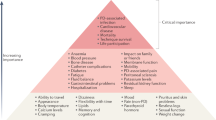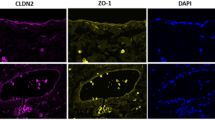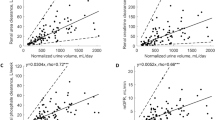Abstract
In patients on peritoneal dialysis (PD), a strong inter-relationship exists between the peritoneal membrane and the kidney. This Perspectives article will focus on the mechanisms by which alterations in peritoneal membrane function may influence residual renal function and vice versa. In addition, it will discuss how exposure to PD solutions and inhibitors of the renin–angiotensin–aldosterone system can simultaneously affect both the peritoneal membrane and the kidney. Similar to the cardiorenal syndrome, where changes in one organ system result in changes in the other, we propose the existence of a 'peritoneal–renal syndrome', with this novel term encompassing the complex interaction between the peritoneal membrane and the kidneys among patients on PD.
This is a preview of subscription content, access via your institution
Access options
Subscribe to this journal
Receive 12 print issues and online access
$209.00 per year
only $17.42 per issue
Buy this article
- Purchase on Springer Link
- Instant access to full article PDF
Prices may be subject to local taxes which are calculated during checkout
Similar content being viewed by others
References
Bongartz, L. G., Cramer, M. J., Doevendans, P. A., Joles, J. A. & Braam, B. The severe cardiorenal syndrome: 'Guyton revisited'. Eur. Heart J. 26, 11–17 (2005).
Combet, S. et al. Chronic uremia induces permeability changes, increased nitric oxide synthase expression, and structural modifications in the peritoneum. J. Am. Soc. Nephrol. 12, 2146–2157 (2001).
Williams, J. D. et al. Morphologic changes in the peritoneal membrane of patients with renal disease. J. Am. Soc. Nephrol. 13, 470–479 (2002).
Chung, S. H., Heimburger, O., Stenvinkel, P., Bergstrom, J. & Lindholm, B. Association between inflammation and changes in residual renal function and peritoneal transport rate during the first year of dialysis. Nephrol. Dial. Transplant. 16, 2240–2245 (2001).
Davies, S. J. et al. Longitudinal membrane function in functionally anuric patients treated with APD: data from EAPOS on the effects of glucose and icodextrin prescription. Kidney Int. 67, 1609–1615 (2005).
Noh, H. et al. Angiotensin II mediates high glucose-induced TGF-beta1 and fibronectin upregulation in HPMC through reactive oxygen species. Perit. Dial. Int. 25, 38–47 (2005).
Ha, H., Yu, M. R. & Lee, H. B. High glucose-induced PKC activation mediates TGF-beta 1 and fibronectin synthesis by peritoneal mesothelial cells. Kidney Int. 59, 463–470 (2001).
[No authors listed] Adequacy of dialysis and nutrition in continuous peritoneal dialysis: association with clinical outcomes. Canada-USA (CANUSA) Peritoneal Dialysis Study Group. J. Am. Soc. Nephrol. 7, 198–207 (1996).
Churchill, D. N. et al. Increased peritoneal membrane transport is associated with decreased patient and technique survival for continuous peritoneal dialysis patients. The Canada-USA (CANUSA) Peritoneal Dialysis Study Group. J. Am. Soc. Nephrol. 9, 1285–1292 (1998).
Chung, S. H., Heimburger, O., Stenvinkel, P., Qureshi, A. R. & Lindholm, B. Association between residual renal function, inflammation and patient survival in new peritoneal dialysis patients. Nephrol. Dial. Transplant. 18, 590–597 (2003).
Oh, K. H. et al. Baseline peritoneal solute transport rate is not associated with markers of systemic inflammation or comorbidity in incident Korean peritoneal dialysis patients. Nephrol. Dial. Transplant. 23, 2356–2364 (2008).
Rumpsfeld, M., McDonald, S. P., Purdie, D. M., Collins, J. & Johnson, D. W. Predictors of baseline peritoneal transport status in Australian and New Zealand peritoneal dialysis patients. Am. J. Kidney Dis. 43, 492–501 (2004).
Chung, S. H., Heimburger, O., Stenvinkel, P., Wang, T. & Lindholm, B. Influence of peritoneal transport rate, inflammation, and fluid removal on nutritional status and clinical outcome in prevalent peritoneal dialysis patients. Perit. Dial. Int. 23, 174–183 (2003).
Lui, S. L. et al. Cefazolin plus netilmicin versus cefazolin plus ceftazidime for treating CAPD peritonitis: effect on residual renal function. Kidney Int. 68, 2375–2380 (2005).
Shin, S. K. et al. Risk factors influencing the decline of residual renal function in continuous ambulatory peritoneal dialysis patients. Perit. Dial. Int. 19, 138–142 (1999).
Badve, S. V. et al. Use of aminoglycosides for peritoneal dialysis-associated peritonitis does not affect residual renal function. Nephrol. Dial. Transplant. 27, 381–387 (2012).
Baker, R. J., Senior, H., Clemenger, M. & Brown, E. A. Empirical aminoglycosides for peritonitis do not affect residual renal function. Am. J. Kidney Dis. 41, 670–675 (2003).
Shemin, D., Maaz, D., St Pierre, D., Kahn, S. I. & Chazan, J. A. Effect of aminoglycoside use on residual renal function in peritoneal dialysis patients. Am. J. Kidney Dis. 34, 14–20 (1999).
Han, S. H. et al. Reduced residual renal function is a risk of peritonitis in continuous ambulatory peritoneal dialysis patients. Nephrol. Dial. Transplant. 22, 2653–2658 (2007).
Perez Fontan, M. et al. Peritonitis-related mortality in patients undergoing chronic peritoneal dialysis. Perit. Dial. Int. 25, 274–284 (2005).
Szeto, C. C. et al. Independent effects of residual renal function and dialysis adequacy on nutritional status and patient outcome in continuous ambulatory peritoneal dialysis. Am. J. Kidney Dis. 34, 1056–1064 (1999).
Girndt, M., Sester, M., Sester, U., Kaul, H. & Kohler, H. Defective expression of B7–2 (CD86) on monocytes of dialysis patients correlates to the uremia-associated immune defect. Kidney Int. 59, 1382–1389 (2001).
Lim, W. H., Kireta, S., Leedham, E., Russ, G. R. & Coates, P. T. Uremia impairs monocyte and monocyte-derived dendritic cell function in hemodialysis patients. Kidney Int. 72, 1138–1148 (2007).
Davies, S. J. Longitudinal relationship between solute transport and ultrafiltration capacity in peritoneal dialysis patients. Kidney Int. 66, 2437–2445 (2004).
Moist, L. M. et al. Predictors of loss of residual renal function among new dialysis patients. J. Am. Soc. Nephrol. 11, 556–564 (2000).
Bajo, M. A. et al. Icodextrin effluent leads to a greater proliferation than glucose effluent of human mesothelial cells studied ex vivo. Perit. Dial. Int. 20, 742–747 (2000).
Liberek, T. et al. Cell function and viability in glucose polymer peritoneal dialysis fluids. Perit. Dial. Int. 13, 104–111 (1993).
Posthuma, N. et al. Peritoneal kinetics and mesothelial markers in CCPD using icodextrin for daytime dwell for two years. Perit. Dial. Int. 20, 174–180 (2000).
Nakao, A. et al. Effects of icodextrin peritoneal dialysis solution on the peritoneal membrane in the STZ-induced diabetic rat model with partial nephrectomy. Nephrol. Dial. Transplant. 25, 1479–1488 (2010).
Takatori, Y. et al. Icodextrin increases technique survival rate in peritoneal dialysis patients with diabetic nephropathy by improving body fluid management: a randomized controlled trial. Clin. J. Am. Soc. Nephrol. 6, 1337–1344 (2011).
Davies, S. J. et al. Icodextrin improves the fluid status of peritoneal dialysis patients: results of a double-blind randomized controlled trial. J. Am. Soc. Nephrol. 14, 2338–2344 (2003).
Davies, S. J. et al. Longitudinal relationships between fluid status, inflammation, urine volume and plasma metabolites of icodextrin in patients randomized to glucose or icodextrin for the long exchange. Nephrol. Dial. Transplant. 23, 2982–2988 (2008).
Paniagua, R. et al. Icodextrin improves metabolic and fluid management in high and high-average transport diabetic patients. Perit. Dial. Int. 29, 422–432 (2009).
Qi, H., Xu, C., Yan, H. & Ma, J. Comparison of icodextrin and glucose solutions for long dwell exchange in peritoneal dialysis: a meta-analysis of randomized controlled trials. Perit. Dial. Int. 31, 179–188 (2011).
Jansen, M. A. et al. Predictors of the rate of decline of residual renal function in incident dialysis patients. Kidney Int. 62, 1046–1053 (2002).
Nakamoto, H. et al. Role of the renin-angiotensin system in the pathogenesis of peritoneal fibrosis. Perit. Dial. Int. 28 (Suppl. 3), S83–S87 (2008).
Mortier, S., Faict, D., Lameire, N. H. & De Vriese, A. S. Benefits of switching from a conventional to a low-GDP bicarbonate/lactate-buffered dialysis solution in a rat model. Kidney Int. 67, 1559–1565 (2005).
Forbes, J. M., Cooper, M. E., Oldfield, M. D. & Thomas, M. C. Role of advanced glycation end products in diabetic nephropathy. J. Am. Soc. Nephrol. 14 (Suppl. 3), S254–S258 (2003).
Justo, P., Sanz, A. B., Egido, J. & Ortiz, A. 3,4-Dideoxyglucosone-3-ene induces apoptosis in renal tubular epithelial cells. Diabetes 54, 2424–2429 (2005).
Kim, C. D. et al. Effects of low glucose degradation products peritoneal dialysis fluid on the peritoneal fibrosis and vascularization in a chronic rat model. Ther. Apher. Dial. 11, 56–64 (2007).
Kawanishi, K., Honda, K., Tsukada, M., Oda, H. & Nitta, K. Neutral solution low in glucose degradation products is associated with less peritoneal fibrosis and vascular sclerosis in patients receiving peritoneal dialysis. Perit. Dial. Int. http://dx.doi.org/10.3747/pdi.2011.00270.
Williams, J. D. et al. The Euro-Balance Trial: the effect of a new biocompatible peritoneal dialysis fluid (balance) on the peritoneal membrane. Kidney Int. 66, 408–418 (2004).
Kim, S. et al. Benefits of biocompatible PD fluid for preservation of residual renal function in incident CAPD patients: a 1-year study. Nephrol. Dial. Transplant. 24, 2899–2908 (2009).
Montenegro, J. et al. Use of pure bicarbonate-buffered peritoneal dialysis fluid reduces the incidence of CAPD peritonitis. Nephrol. Dial. Transplant. 22, 1703–1708 (2007).
Fan, S. L., Pile, T., Punzalan, S., Raftery, M. J. & Yaqoob, M. M. Randomized controlled study of biocompatible peritoneal dialysis solutions: effect on residual renal function. Kidney Int. 73, 200–206 (2008).
Choi, H. Y. et al. The clinical usefulness of peritoneal dialysis fluids with neutral pH and low glucose degradation product concentration: an open randomized prospective trial. Perit. Dial. Int. 28, 174–182 (2008).
Szeto, C. C. et al. Clinical biocompatibility of a neutral peritoneal dialysis solution with minimal glucose-degradation products--a 1-year randomized control trial. Nephrol. Dial. Transplant. 22, 552–559 (2007).
Johnson, D. W. et al. Effects of biocompatible versus standard fluid on peritoneal dialysis outcomes. J. Am. Soc. Nephrol. 23, 1097–1107 (2012).
Haag-Weber, M. et al. Low-GDP fluid (Gambrosol trio) attenuates decline of residual renal function in PD patients: a prospective randomized study. Nephrol. Dial. Transplant. 25, 2288–2296 (2010).
Kiribayashi, K. et al. Angiotensin II induces fibronectin expression in human peritoneal mesothelial cells via ERK1/2 and p38 MAPK. Kidney Int. 67, 1126–1135 (2005).
Lewis, E. J., Hunsicker, L. G., Bain, R. P. & Rohde, R. D. The effect of angiotensin-converting-enzyme inhibition on diabetic nephropathy. The Collaborative Study Group. N. Engl. J. Med. 329, 1456–1462 (1993).
Lewis, E. J. et al. Renoprotective effect of the angiotensin-receptor antagonist irbesartan in patients with nephropathy due to type 2 diabetes. N. Engl. J. Med. 345, 851–860 (2001).
Brenner, B. M. et al. Effects of losartan on renal and cardiovascular outcomes in patients with type 2 diabetes and nephropathy. N. Engl. J. Med. 345, 861–869 (2001).
[No authors listed] Randomised placebo-controlled trial of effect of ramipril on decline in glomerular filtration rate and risk of terminal renal failure in proteinuric, non-diabetic nephropathy. The GISEN Group (Gruppo Italiano di Studi Epidemiologici in Nefrologia). Lancet 349, 1857–1863 (1997).
Sauter, M. et al. ACE inhibitor and AT1-receptor blocker attenuate the production of VEGF in mesothelial cells. Perit. Dial. Int. 27, 167–172 (2007).
Duman, S. et al. Does enalapril prevent peritoneal fibrosis induced by hypertonic (3.86%) peritoneal dialysis solution? Perit. Dial. Int. 21, 219–224 (2001).
Duman, S., Sen, S., Duman, C. & Oreopoulos, D. G. Effect of valsartan versus lisinopril on peritoneal sclerosis in rats. Int. J. Artif. Organs 28, 156–163 (2005).
Kolesnyk, I. et al. Impact of ACE inhibitors and AII receptor blockers on peritoneal membrane transport characteristics in long-term peritoneal dialysis patients. Perit. Dial. Int. 27, 446–453 (2007).
Kolesnyk, I., Noordzij, M., Dekker, F. W., Boeschoten, E. W. & Krediet, R. T. A positive effect of AII inhibitors on peritoneal membrane function in long-term PD patients. Nephrol. Dial. Transplant. 24, 272–277 (2009).
Johnson, D. W. et al. Predictors of decline of residual renal function in new peritoneal dialysis patients. Perit. Dial. Int. 23, 276–283 (2003).
Singhal, M. K. et al. Rate of decline of residual renal function in patients on continuous peritoneal dialysis and factors affecting it. Perit. Dial. Int. 20, 429–438 (2000).
Li, P. K., Chow, K. M., Wong, T. Y., Leung, C. B. & Szeto, C. C. Effects of an angiotensin-converting enzyme inhibitor on residual renal function in patients receiving peritoneal dialysis. A randomized, controlled study. Ann. Intern. Med. 139, 105–112 (2003).
Suzuki, H., Kanno, Y., Sugahara, S., Okada, H. & Nakamoto, H. Effects of an angiotensin II receptor blocker, valsartan, on residual renal function in patients on CAPD. Am. J. Kidney Dis. 43, 1056–1064 (2004).
Author information
Authors and Affiliations
Contributions
S. J. Nessim researched data for the article. Both authors made substantial contributions to discussion of content, writing the article and review/editing of the manuscript before submission.
Corresponding author
Ethics declarations
Competing interests
S. J. Nessim declares an association with the following company: Baxter Healthcare (speaker honoraria). J. M. Bargman declares associations with the following companies: Amgen (speaker honoraria; consultant), Baxter Healthcare (speaker honoraria; consultant), DaVita Healthcare (speaker honoraria), Otsuka (speaker honoraria; consultant).
Rights and permissions
About this article
Cite this article
Nessim, S., Bargman, J. The peritoneal–renal syndrome. Nat Rev Nephrol 9, 302–306 (2013). https://doi.org/10.1038/nrneph.2013.43
Published:
Issue Date:
DOI: https://doi.org/10.1038/nrneph.2013.43
This article is cited by
-
Effectiveness of Renin-Angiotensin-Aldosterone System Blockade on Residual Kidney Function and Peritoneal Membrane Function in Peritoneal Dialysis Patients: A Network Meta-Analysis
Scientific Reports (2019)
-
Volume control in treatment-resistant congestive heart failure: role for peritoneal dialysis
Heart Failure Reviews (2014)



